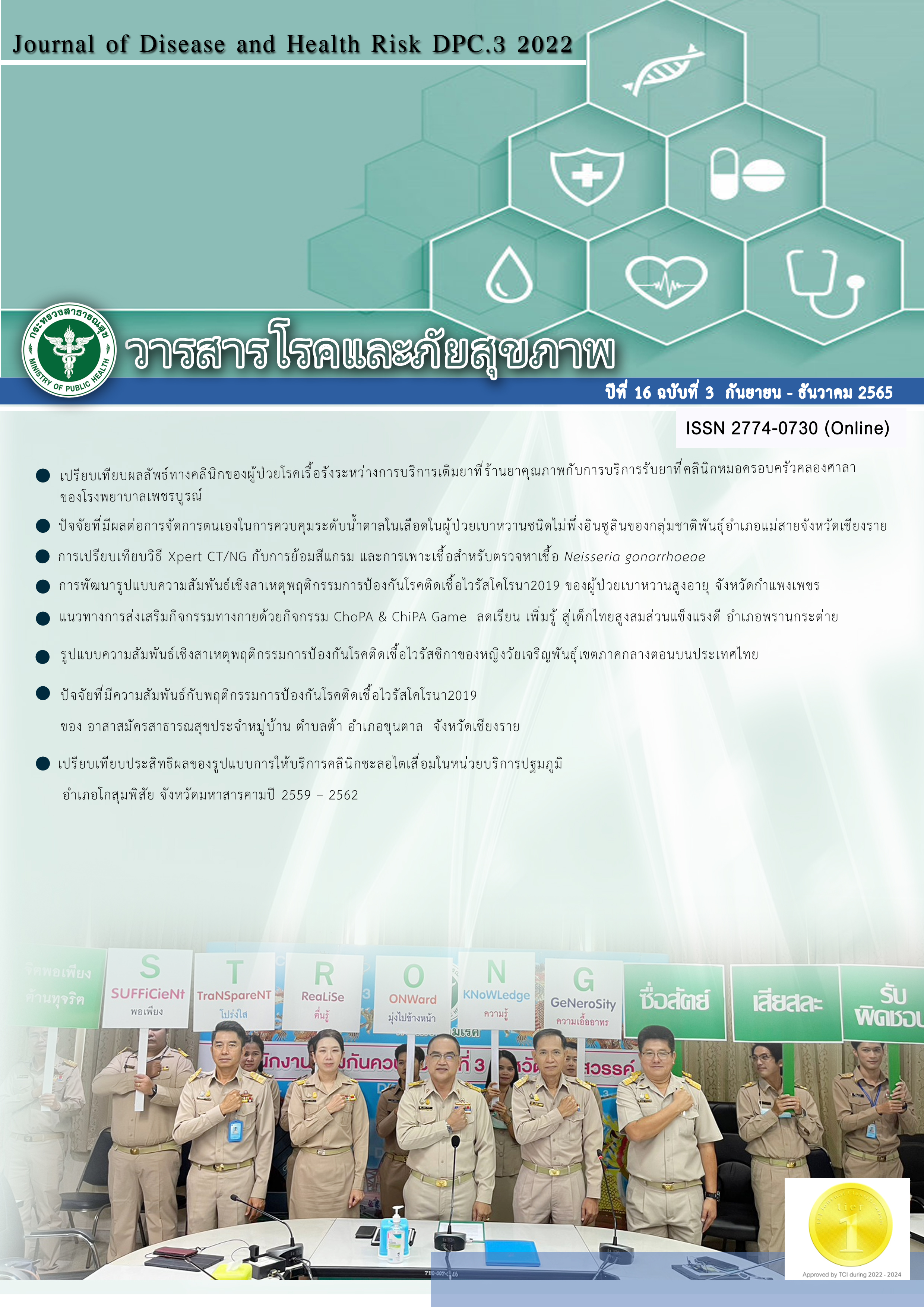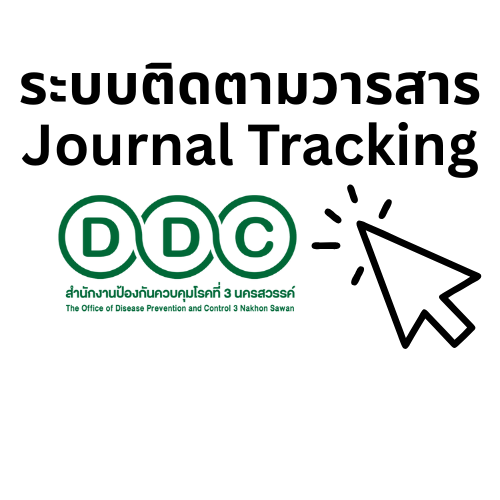Factors Affecting Self-management in Controlling Blood Sugar Levels among Ethnic Groups Patients with Non-insulin Dependent Diabetes Mellitus, Mae Sai District, Chiang Rai Province
Keywords:
non-insulin dependent diabetes mellitus, ethnic groups, self-managementAbstract
This cross sectional descriptive study aimed to study self-management on glycemic control among ethnic non-insulin dependent diabetic patients and identify factors affecting self-management on glycemic control among ethnic non-insulin dependent diabetic patients, Mae Sai District, Chiang Rai Province. The one hundred and ninety-two participants were selected by using systematic random sampling. Data were collected by questionnaires between February 1, 2022–February 28, 2022, analyzed by multiple regression. The results revealed that most of them had self-management in eating and taking medicine at high level (76.0%,75.0%), self-management in exercise and stress at moderate level (51.0%, 52.6%). There were 3 factors affecting self-management included self-efficacy in diabetes self-management (p<0.001), knowledge of diabetes (p<0.001) and perceived benefits in diabetes self-management (p=0.001). The predictive equation was diabetes self-management score=45.488+0.703 (self-efficacy in diabetes self-management)+0.707 (knowledge of diabetes)+0.615(perceived benefits in diabetes self-management). Therefore, service unit should apply the finding to plan for problem solving as increases self-efficacy in diabetes self-management, knowledge of diabetes and perceived benefits in diabetes self-management among ethnic non-insulin dependent diabetic patients.
References
สมาคมโรคเบาหวานแห่งประเทศไทยในพระราชูปถัมภ์สมเด็จพระเทพรัตนราชสุดาฯ สยามบรมราชกุมารี. สาระความรู้สำหรับบุคลากรทางการแพทย์ ประจำวันที่ 3 สิงหาคม 2564 [อินเทอร์เน็ต].2564 [เข้าถึงเมื่อ 3 สิงหาคม 2564]. เข้าถึงได้จาก: https://www.dmthai.org/index.php.
สำนักงานสาธารณสุขจังหวัดเชียงราย. อัตราการป่วยด้วยโรคเบาหวาน เขตสุขภาพที่ 1 ประจำวันที่ 3 สิงหาคม 2564 [อินเทอร์เน็ต].2564 [เข้าถึงเมื่อ 3 สิงหาคม 2564]. เข้าถึงได้จาก:https://cri.hdc.moph.go.th/hdc/reports/page.php?cat_id=b2b59e64c4e6c92d4b1ec16a599d88b
วิทยา ศรีดามา. การดูแลรักษาผู้ป่วยเบาหวาน. พิมพ์ครั้งที่ 3. กรุงเทพฯ : จุฬาลงกรณ์มหาวิทยาลัย; 2545.
สำนักงานคณะกรรมการส่งเสริมวิทยาศาสตร์ วิจัยและนวัตกรรม. กลุ่มชาติพันธุ์ในประเทศไทย งานวิจัยและความท้าทาย ประจำวันที่ 3 สิงหาคม 2564 [อินเทอร์เน็ต].2564 [เข้าถึงเมื่อ 3 สิงหาคม 2564]. เข้าถึงได้จาก:https://www.tsri.or.th/dl/548
อมรา พงศาพิชญ์. วัฒนธรรม ศาสนา และชาติพันธุ์ : วิเคราะห์สังคมไทย แนวมานุษยวิทยา. พิมพ์ครั้งที่ 3. กรุงเทพฯ: จุฬาลงกรณ์มหาวิทยาลัย. 2537.
โรงพยาบาลแม่สาย จังหวัดเชียงราย. ประวัติโรงพยาบาลแม่สาย. ประจำวันที่ 3 สิงหาคม 2564
[อินเทอร์เน็ต].2564 [เข้าถึงเมื่อ 3 สิงหาคม 2564]. เข้าถึงได้จากhttp://www.maesaihospital.com/page_a.php?cid=11
โรงพยาบาลแม่สาย จังหวัดเชียงราย. งานเวชระเบียนและสถิติโรงพยาบาลแม่สาย ผู้ป่วยด้วยโรคเบาหวาน โรงพยาบาลแม่สายประจำวันที่ 3 สิงหาคม 2564 [อินเทอร์เน็ต].2564 [เข้าถึงเมื่อ 3 สิงหาคม 2564]. เข้าถึงได้จากhttp://www.maesaihospital.com/page_a.php?cid=11
Apidechkul T. Prevalence and factors associated with type 2 diabetes mellitus and hypertension among the hill tribe elderly populations in northern Thailand. BMC Public Health 2018; 18:694.
ศูนย์อนามัยกลุ่มชาติพันธุ์ ชายขอบ และแรงงานข้ามชาติ กรมอนามัย. แผนแม่บทการพัฒนากลุ่มชาติพันธุ์ในประเทศไทย (2558-2560) กระทรวงการพัฒนาสังคมและความมั่นคงของมนุษย์ ประจำวันที่ 3 สิงหาคม 2564 [อินเทอร์เน็ต].2564 [เข้าถึงเมื่อ 3 สิงหาคม 2564]. เข้าถึงได้จาก:https://hhdc.anamai.moph.go.th/th/master-plan-for-ethnic-development-in-thailand.
Phetarvut S, Watthayu N , Suwonnaroop, N. Factors Predicting Diabetes Self-management Behavior among Patients with Diabetes Mellitus Type 2. Nursing Science Journal of Thailand, 2012; 29(4): 18–26.
Rosenstovk IM. The Health Belief Model and Prevention Behavior. Health Education Monographs 1974; 2(4): 354-86.
Glanz K, Rimer BK, Viswanath K."V."(Eds.).Theory, research, and practice in health behavior. In K Glanz, BK Rimer, & K. "V." Viswanath (Eds.), Health behavior: Theory, research, and practice (2015). (pp. 23–41). Jossey-Bass/Wiley.
Creer LT. Self-management of chronic illness. Handbook of self-regulation.
California: Academic. 2000; 601-29.
Ngamjarus C, Chongsuvivatwong V, McNeil E. n4Studies: Sample Size Calculation for an Epidemiological Study on a Smart Device. Siriraj Med J, 2016; 68: 160-70.
ฐิติภัทร จันเกษม.ปัจจัยพยากรณ์ระดับน้ำตาลในเลือดของผู้ป่วยโรคเบาหวานชนิดที่ 2 ในโรงพยาบาลคลองลาน จังหวัดกำแพงเพชร. วารสารวิชาการมหาวิทยาลัยอีสเทิร์นเอเชีย ฉบับวิทยาศาสตร์และเทคโนโลยี 2562; 13: 95-06.
กมลพร สิริคุตจตุพร. ปัจจัยทำนายพฤติกรรมการจัดการตนเองของผู้สูงอายุโรคเบาหวานชนิดที่ 2 วารสารสภาการพยาบาล 2560; 32: 81-93.
Assntachai P, editor. Health problems in older persons and prevention. Bangkok: Department of Preventive and pocial medicinefaculty of Medicine Siriraj hospital Mahidol University; 2011.
อภิชัย คุณีพงษ์. ปัจจัยที่มีอิทธิพลต่อพฤติกรรมการดูแลตนเองของผู้ป่วยโรคเบาหวานชนิดที่ 2 ในอำเภอพัฒนานิคม จังหวัดลพบุรี. วารสารกรมการแพทย์ 2561; 3: 101-7.
Downloads
Published
How to Cite
Issue
Section
License
Copyright (c) 2022 Journal of Disease and Health Risk DPC.3

This work is licensed under a Creative Commons Attribution-NonCommercial-NoDerivatives 4.0 International License.
Copyright notice
Article published in the Journal of Disease and Health Risk DPC.3 Nakhon Sawan. It is considered a work of academic research and analysis as well as the personal opinion of the author. It is not the opinion of the Office of Disease Prevention and Control 3, Nakhon Sawan. Or the editorial team in any way Authors are responsible for their articles.
Privacy Policy
Name, address and e-mail address specified in the Journal of Disease and Health Risk DPC.3 Nakhon Sawan. It is used for identification purposes of the journal. And will not be used for any other purpose. Or to another person.









